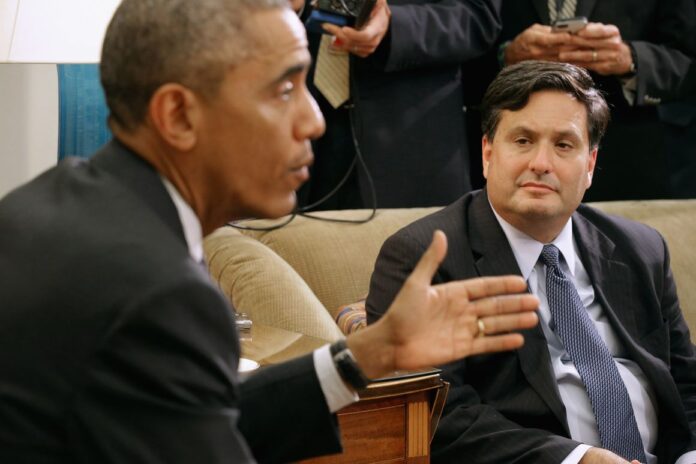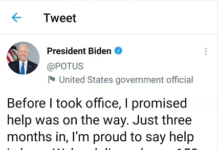Now Biden is president-elect, and last week he appointed Klain to be his White House chief of staff, elevating a veteran of Washington’s political wars to a job in which he’ll have to navigate even more hostile waters than the Obama administration did in 2009.
Klain, it turned out, was right to worry about the politics of a jobs bill during a jobs crisis: He ended up overseeing the stimulus, and while it was an economic success, it was even more politically damaging than he feared. Now that Klain will be returning to the White House as chief of staff to Biden—and stimulus is once again in the air—his work on the so-called Recovery Act sheds light on his managerial and political chops.
Klain, who had previously served as chief of staff to Vice President Al Gore, had always been the kind of chief of staff who focuses more on the staff than acting like a chief. His genial but hard-charging approach proved remarkably successful in getting stimulus dollars out the door quickly while avoiding fraud and abuse. But while Klain is also a political animal who was always keenly aware of the political ramifications of the Recovery Act, he was still involved in some of its worst political debacles, from the ill-fated “Recovery Summer” to the bankruptcy of Solyndra.
In varying roles as Biden’s staff director on the Senate Judiciary Committee, Gore’s legal eagle overseeing the 2000 Florida recount and Obama’s czar coordinating the federal response to the Ebola virus, Klain has always been seen as a get-things-done kind of Democrat, a problem-solver who isn’t particularly radical but believes in the power of well-managed government to improve people’s lives. His colleagues on the Recovery Act saw him as a common-sense, detail-oriented bureaucratic magician who always saw the forest as well as the trees. But he lost some of his optimism about bipartisanship after the GOP crusade against the Recovery Act, and got nearly as irritated by stimulus complaints from the left.
Biden spokesman Andrew Bates said Klain’s leadership on the stimulus as well as Ebola was “central” to the president-elect’s decision to rehire him—and that those experiences couldn’t be timelier now. Republicans learned to respect him; former Republican Rep. David Jolly, who quit the party after Trump’s ascendance, called Klain “one of the smartest people in Washington.”
Klain’s colleagues in Obamaworld see him as a kind of Harvard Law School consigliere who can translate Biden’s desires into action, mixing intelligence and competence with hard-won Washington wisdom.
“You know how they say listening to Mozart aligns your brain cells in useful ways? That’s my experience in bringing the gnarliest problems to Ron,” says Jared Bernstein, who was Biden’s top economist in the vice president’s office and advised his campaign as well. “I walk away thinking far more clearly, and I guarantee you that experience is not unique to me.”
Biden is certainly going to face some gnarly problems, taking office amid a raging pandemic, another economic crisis and a fraught social justice reckoning. He will probably preside over a divided government, and he will certainly preside over a divided nation after a bitterly contested election. He has placed his trust in Klain to help him get things done, and also to help him get the politics right, which will require Klain to learn some lessons from the past.
In February 2009, Biden visited a crumbling 80-year-old bridge outside Carlisle, Pennsylvania, that seemed to be crying out for stimulus; he noticed that one rusty girder was actually missing rivets. Pennsylvania governor Ed Rendell dubbed it the Biden Bridge, and the vice president assured the assembled media that men with hard hats and jackhammers would start repairing it and the local economy once the Recovery Act became the law of the land.
After the Democratic Congress passed the stimulus later that month, with only three Republican senators voting yes, Klain called to find out when Biden could return to Carlisle for the groundbreaking. A state official eventually called back to tell him: June.
“JUNE???” Klain gasped. “This was the number one project on your list!”
It turned out that local school buses depended on the bridge, so the town didn’t want to shut it down for repairs until summer vacation.
“From the town’s perspective, it made perfect sense,” Klain later recalled in an interview for my book about the Obama stimulus, The New New Deal. “From our perspective, it was a disaster. We had told everyone this would happen fast.”
The Recovery Act would finance 22,000 miles of road improvements in that first year, but the delays and snafus tended to get more attention than the hard hats or jackhammers. Biden and Klain rode herd on mayors and governors around the country, and federal dollars started circulating into America’s economic bloodstream so quickly that the Great Recession ended by midyear. But the politics were consistently abysmal.
One early example was the White House decision to leak out the Recovery Act’s tax cuts a few dollars a week by reducing federal withholding, instead of sending Americans big checks with Obama’s name on them. The economic rationale was research showing that people who receive big windfalls are less likely to spend them once they notice them—so if you really want to goose the economy, the smart move is to dribble money quietly into people’s paychecks. Politically, though, it’s usually a good thing when people notice they’re getting money from the government; this felt like sending flowers to a romantic interest without signing the note. Ultimately, 95 percent of Americans got tax cuts, and less than 10 percent were aware they got tax cuts.
“The political theory was if you do the right thing, and you get results, that’s good politics,” Klain told me later. “In retrospect, it just seems stupid.”
It was a painful lesson for Klain. He was running a governmentwide effort to spend money with unprecedented speed, and the results were often extraordinary. Experts had warned that as much as 5 percent of the stimulus could be stolen, but an aggressive oversight board documented only $7.2 million in fraud through 2011, about 0.001 percent.
Politically, though, the Recovery Act quickly became a Washington joke, and polls showed that fewer Americans believed it had created jobs than believed Elvis was alive.
This was mainly because Republicans marched in almost unanimous lockstep against the stimulus, and did a masterful job branding it as a Big Government big deficit “Porkulus.” Klain got especially frustrated by the drumbeat of Republican criticism about National Institutes of Health studies of topics like teenage sexual habits or monkeys’ responses to cocaine. Republican Senator Arlen Specter had demanded $10 billion for NIH in exchange for supporting the Recovery Act, and funny-sounding NIH studies ended up getting tons of negative press.
“The Republicans say: See? Classic government waste!” Klain groused. “Well, Specter was the 60th flipping vote! Without cocaine monkeys, there’s no tax cuts and no roads!”
Klain later described the GOP crusade against the stimulus as “a real wake-up call,” a foreshadowing that Republicans would never compromise with Obama on his next big policy goal of health care reform. He could see Republicans hoped to take back Washington by obstructing Obama and then calling him out for breaking his promises to bring back bipartisan cooperation. “When Republicans can’t support tax cuts and infrastructure they’ve always supported in the past, that’s a pretty strong sign they’re not going to support anything with Obama’s name on it,” he said.
At the same time, it infuriated Klain when politically clueless liberals complained the stimulus should have been larger. Almost everyone in the White House had wanted as large a stimulus as possible, to ease as much pain and create as many jobs as possible, but the three Republican senators and several Democrats had insisted it could be no larger than $800 billion.
“The idea that everyone knew this would be too small and we just punked out, it’s ridiculous,” Klain said. “We felt like we were in the deep end of the pool.”
Klain really did want to pump as much public money into the economy as Congress would approve, but his inner policy wonk never entirely crowded out his inner political hack. In the fall of 2009, Bernstein pitched Klain on a plan to create a National Inventory of Structures, a “geo-coded database” of every building in America.
“You’re kidding, right?” Klain asked.
Bernstein was not kidding. For just $1 billion, he explained, the administration could keep 750,000 census workers on the payroll for an extra two months, while creating a valuable resource for local planning departments and academic researchers.
“What are you trying to do to us?” Klain groaned. “I think we could sell a plan to build buildings. We cannot sell a plan to COUNT buildings!”
It was hard to sell anything when the economy remained sluggish. Klain kept pushing for Obama to attend Recovery Act events to boost the Recovery Act’s popularity, but most Obama aides wanted to keep him away from Recovery Act events to protect his own popularity. This came to a head during the politically disastrous “Recovery Summer” of 2010, when Biden barnstormed the country to promote a new wave of stimulus projects just as state-level budget cuts and a Greek debt crisis threatened to tip the U.S. economy back into recession. The vice president ended up looking silly, and Republicans took back the House in that year’s midterms.
“We went out there just as the bad news was mounting,” Klain said. “If you look at what we said, we were right. The construction numbers went way up. But we still got lampooned.”
Klain was also influential in getting Obama to visit Solyndra, a high-tech California solar manufacturer that had attracted $1 billion in private financing from an all-star team of investors as well as a $465 million stimulus loan. Klain was a big supporter of the Recovery Act’s efforts to jump-start the clean energy economy, and he pushed for a presidential visit even though some Democrats in the industry were sounding alarms about Solyndra.
“Sounds like there are some risk factors here, but that’s true of any innovative company POTUS would visit,” he wrote in an email to Obama aide Valerie Jarrett. “It looks OK to me. … The reality is that if POTUS visited 10 such places over the next 10 months, probably a few will be belly-up by election day 2012—but that to me is the reality of saying we want to help promote cutting-edge, new-economy industries.”
Solyndra later went bankrupt, and while a slew of hearings found no wrongdoing, Republicans have referred to it ever since as a symbol of crony capitalism. But the loan program that financed Solyndra has ended up making money for taxpayers, while supporting some of the world’s largest wind and solar plants. One reason that Solyndra, the actual company, failed was that the stimulus helped reduce the cost of solar panels, and that’s one reason U.S. solar capacity has soared.
I never heard anyone criticize Klain’s management of the Recovery Act, not even sponsors of dog parks and other wasteful-sounding projects that he helped scuttle. But his political instincts about the Recovery Act were not always spot on. For example, he expected its high-speed rail investment to be a huge political asset for Obama in 2012, and he expected Republican governors like Scott Walker in Wisconsin, John Kasich in Ohio and Rick Scott in Florida to pay a steep price for killing projects in their states. It wasn’t, and they didn’t. Klain predicted there would be ads in those states bemoaning the loss of rail jobs, but there weren’t.
Klain’s initial instinct, that the stimulus would be hard to message, turned out to be more prescient than his subsequent hopes that its substantive success would create a political benefit. In retrospect, he looked back at some of those early meetings during the transition when Obama’s aides were searching for programs that could absorb tens of billions of dollars, an Alice in Wonderland contrast to vicious Clinton White House battles over a few million.
“If we thought it was odd that we were struggling to find ways to spend more money, it probably shouldn’t have surprised us that the American people would find it odd, too,” he said.
Now Klain is returning to the White House during a new jobs crisis, and this time Congress has already injected $4 trillion into the economy. But Biden has said he wants a lot more, preferably with some of the investments in clean energy and other long-term priorities that he loved in the Recovery Act. Once again, Biden will count on Klain to make the government work. And in a time of divided government, they’ll both hope the divided country doesn’t relapse into stimulus fatigue.








